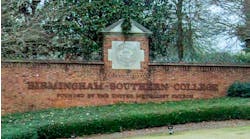Managing the costs of constructing an education facility begins well before groundbreaking — it starts with an effective project execution plan. Pre-construction planning addresses two key parts of the financial equation: developing and managing an accurate budget, and developing and executing a cost-effective procurement strategy.
Developing an accurate budget requires several pre-construction disciplines: professional estimating; value management; constructibility reviews; development of an effective construction strategy and realistic schedule; and risk analysis and contingency planning. Similarly, an effective procurement strategy depends on identifying and managing “long-lead” equipment and materials, and coordinating delivery at the optimal time in the construction process.
Building the budget
Establishing an accurate budget begins at the earliest possible stage of the project — ideally at the programming stage. An institution, design team and construction team need to work together to capture the scope and intent of the project, including the program, needs of the school or university, level of quality and sustainability goals.
A construction manager (CM) can bring the skills and experience of its professional estimators to the table. Professional estimators prepare detailed assessments at every stage of design documentation and track the design against the budget. Cost estimates are used as a tool to maintain the overall project budget and enhance the building as related to life-cycle costs, quality, building components, and the scope and cost of all building systems. Benchmarking is used to develop estimates and to verify that the estimated costs fall within the proper range for projects of that type and complexity — whether it is a classroom building, library or sophisticated research laboratory — in a particular geographic region.
Estimators typically will examine building systems first because these have a major impact on total project cost; then they will look at the concepts behind the building design, and finally, equipment and materials. Benchmarks are developed from comparisons of projects of similar type, size, scope and location, and the architects, engineers and construction professionals review and verify the benchmarks.
However, historical data is only part of the picture. Current and projected market trends also should be tracked and applied to the estimating process. This data is gathered through regular contacts with selected subcontractors and vendors to discuss the issues that affect construction costs, including labor shortages, availability of materials, and manufacturer delivery issues. All the information affects accurate cost modeling and the development of a realistic budget.
As the project design progresses, cost estimators provide increasing levels of detail, with important milestones at schematic design, design development and construction documentation. In parallel, other members of the pre-construction planning team will develop a construction strategy, known as a project execution plan, and a schedule designed to meet the owners' target completion date within the budget.
Developing a well-structured project cost estimate and schedule in the early planning phases of a project sets the stage for effective decisionmaking by the project team. The pre-construction planning team should perform constructibility reviews and offer value-management alternatives on every project, whether it is a K-12 classroom building or a complex academic research lab, to identify more cost-effective ways to meet the same performance goals without sacrificing scope, quality or aesthetics.
In case of emergency
Every project also should carry a minimum of three contingency funds to cover the potential effects of future budget changes to the size or scope of the building, unforeseeable site conditions, design evolution and its related cost, and unexpected changes in the economy. In the current market, prices of materials such as copper, steel, lumber, glass and gypsum remain volatile; construction prices still are rising in certain hot spots, including Las Vegas, Salt Lake City, southern California, San Francisco, Seattle and New York City.
The owners' contingency fund (typically +/- 10 percent of total project cost) covers changes in the size or scope of the project. Under certain types of contracting arrangements, the CM may carry this contingency in its budget. The construction contingency fund is intended to cover unforeseen conditions after construction has begun; procurement deficiencies and delays, overtime should it be necessary to accelerate the schedule; and the need for additional equipment. A design-estimating contingency also is recommended and carried by the CM for resolution of design details and marketplace changes, which may occur after the issuance of the estimate. As the design progresses and costs are defined in increasing detail, the design-estimating contingency gradually diminishes until the guaranteed maximum price (GMP) is set.
Managing money
The other major part of the financial equation involves an effective procurement strategy. The pre-construction planning team should develop a procurement strategy in parallel with the development of the initial budget and schedule. The overall strategy is designed to leverage market conditions for the benefit of the project.
For example, if the size of the concrete package will put stress on a local contractor, thus inflating the price or setting back the schedule, then the team must look for ways to reduce the impact. In this case, the institution might buy the foundation from one contractor, the slab on grade from a second and the slab on deck from a third. The institution also might decide to use its purchasing power to buy the ready-mix and re-bar, and supply it to the contractors, rather than purchasing these materials from them at a higher price.
Developing a procurement strategy early in the planning phase of the project helps ensure procurement and delivery of all materials and equipment, including long-lead items, at the optimal time in the construction process. In fact, if a particular product can be obtained only from a single vendor — say the project requires an unusual piece of laboratory equipment — then that product should be ordered during the design phase. Without a strategy in place early, the project may be forced into a fast-track procurement process, with associated price premiums and delays.
Contracting for a design assist from a pre-qualified subcontractor is becoming a common way to manage the cost and scheduling of certain critical-path building systems, such as steel framing or a curtainwall. The RFP in a design-assist should require both a price for the design work, as well as a GMP to build or install the system. In the case of steel framing, this process has resulted in timely orders, as well as effective strategies to reduce total weight, thus reducing the total quantity and cost of the steel required for a project.
Sustainability matters
Education institutions have been at the forefront of the movement toward sustainable design and construction because they have realized the value of high-performance buildings in reducing life-cycle costs and enhancing the quality of the experience for users. Yet, many remain concerned about potentially higher costs of a sustainable project.
A LEED-certified building need not cost a premium if this is a fundamental goal at the outset of a project, when the design team can leverage effective site selection, building orientation and massing, and the design of the building envelope to maximize sustainability. Moreover, increasing numbers of manufacturers offer materials and equipment that are compatible with sustainable design, including efficient mechanical, electrical and plumbing systems.
Nevertheless, any project that aims for certification should include a LEED-accredited professional on the project team from day one. This special expertise is invaluable in developing a strategy to maximize the LEED score within the project budget.
Sidebar: A state-of-the-art planning approach
The French Family Science Center at Duke University in Durham, N.C., includes state-of-the-art research and teaching laboratories for genomics, biological chemistry, materials science, nanoscience, physical biology and bioinformatics.
The 275,000-square-foot building has received LEED silver certification and provides space for the departments of chemistry and biology, biological anthropology and anatomy, mathematics and physics.
The center was designed to fit the specific site and to serve five surrounding buildings. The project also included a 12,000-square-foot renovation of the sub-basement level of the biological sciences building and the demolition of five existing structures.
The pre-construction planning team worked closely with the design team to provide strategic analysis, cost estimating, logistics planning and value engineering for the complicated structure. For example, they determined that ceiling heights proposed for underground chemistry labs would be insufficient to accommodate ductwork associated with the fume hoods and the heating and air-conditioning systems. So the design team situated the labs in another area of the building. Based on construction estimates for a large underground auditorium, they also suggested situating it on the ground level, which reduced the cost, and enhanced user circulation and access.
The pre-construction planners also provided guidance in selecting, pricing and procuring specific systems and their components.
Working with the mechanical engineer, the team eliminated costly rooftop mechanical penthouses in favor of air handlers with factory-installed enclosures. A Canadian supplier was identified for the air-handling equipment, which at the time had the advantage of a favorable monetary exchange rate. Lab casework was procured from a Canadian supplier for the same reason.
During the design development phase, the project team developed value-management options totaling $4.6 million (total construction cost: $94.65 million), including:
-
Soil-retention systems: $330,000.
-
Curtainwall and windows: $300,000.
-
Exterior canopies: $450,000.
-
HVAC systems:?$1,850,000.
-
Electrical systems: $550,000.
-
Plumbing systems: $700,000.
The project received LEED silver certification by including the following sustainable-design features:
-
15,000 square feet of green roofs.
-
94 percent of new wood certified by the Forest Stewardship Council.
-
59,000 square feet of recycled carpet.
-
170,000 square feet of recycled ceiling tile and 11,000 square feet of recycled metal ceiling.
-
51 percent water savings resulting from waterless urinals, low-flow water closets and low-flow sinks.
-
275 windows with energy-efficient glazing and reflective louvers to increase daylight penetration.
-
44 percent energy reduction as a result of reflective roofs.
-
Occupancy-sensor-controlled, energy-efficient lighting.
-
Low-flow fume hoods operating at 80 fpm.
-
Heat-recovery system that captures heat or cooling from exhaust air and uses it to pre-heat or pre-cool supply air.



